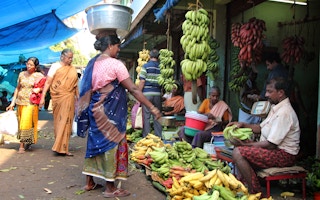Food security has been high on political agendas since 2007/08, when food price spikes sparked social unrest, protests and violent revolts in more than 43 countries (PDF). Around that time, the human population became more urban than rural for the first time ever.
Policymakers need to know how these two facts are related. However, very few of them do.
This is partly because the policy narratives that frame decision-making for food security are outdated and inappropriate. They fail to take account of real rural-urban relationships and the barriers that prevent people from accessing food.
If these narratives don’t change, policies and strategies to enhance food security will surely miss their targets.
My colleagues explain why we need new narratives in this new briefing paper. It is the first output from a multi-year change initiative that aims to find out not only what’s wrong with the food security story, but also how to tailor a more fitting version.
But we don’t have all the answers yet. That’s why we are convening an international network of researchers and practitioners to explore these questions, including through new research.
A cloudy lens
“
This is partly because the policy narratives that frame decision-making for food security are outdated and inappropriate. They fail to take account of real rural-urban relationships and the barriers that prevent people from accessing food.
What we do know is how current narratives are too narrow, and how this can have serious effects. In 2008, for instance, when Ban Ki-moon’s High Level Task Force on the Global Food Security Crisis produced its recommendations, it was clear the authors had looked at the problem through a cloudy lens.
The task force’s comprehensive framework for action focused primarily on addressing rural food production as the solution to food insecurity. As such, it echoed an outdated narrative that describes unsustainable under-production in rural areas and overlooks what limits people’s access to food.
As a result, the World Bank, the United Nations, donor agencies, and other international, regional and national level actors, prioritised tackling the problem of food security through investments in agriculture. This did little to improve urban food security.
What about poverty?
This is because while this narrative is partly right, it is also partly wrong. The production-focused approach tends to overlook the crucial role of food accessibility and affordability for low-income groups particularly, but not only, in urban areas.
Food insecurity is closely related to poverty. But as IIED’s David Satterthwaite has noted, most discussions on food and nutrition in urban areas fail to mention the “inadequate or irregular incomes that are the main reason for hunger”.
By 2050, two out of three people on the planet will live in urban areas (PDF). Nearly all of the increases in the world’s urban population by that date will occur in the global South, especially in Africa and Asia, where a third of urban citizens today live in low-income and informal settlements (PDF).
It is therefore critical that policymakers recognise that despite food being generally more plentiful in urban areas than in the countryside, it is far from uniformly accessible.
Work by the African Food Security Urban Network shows that in Southern African cities a staggering proportion of low income households are food insecure, in some cases over 80 per cent.
Studies in Nairobi’s informal settlements by the African Population and Health Research Centre show similar trends, finding that around half of the residents are food insecure. Perhaps even more disturbing is the centre’s finding that poor food quality has resulted in 42 per cent of households being home to both obese adults and chronically malnourished children.
This, of course, is not to say that rural food security has lost its relevance. But to seriously tackle food insecurity as a whole, a greater understanding of urban food security is needed. A fresh analysis departing from the current emphasis on production will also allow to shed light on the changes that are occurring in both rural and urban areas.
Rural change too
Urbanisation, climate change, rising food prices and the growing mechanisation of agriculture have all contributed to denting the role of farming as the primary source of income and food among the rural poor.
For this reason food purchase, which is critical in urban areas, is increasingly becoming more important in rural areas.
In West Africa, for example, CIRAD research shows that more than half of all imported rice is bought by rural residents. Similarly, in Vietnam – the second largest exporter of rice in the world – more than half of the rural population are net rice buyers (i.e. they buy more rice than they sell).
The blurring lines defining rural producers and urban consumers, as well as the different ways in which people secure regular access to food, food safety, nutritional diversity, and the role (and relation) of formal and informal retailing, are just some of the key elements which need a deeper understanding.
IIED, in collaboration with the Department for International Development (DfID), IFAD and Hivos, have begun a process of rethinking the current narrative on food security by addressing these knowledge gaps relative to the evolving relationship between rural and urban.
Our project will take food consumption as the entry point to fill these gaps and seek to gain a better understanding of the evolving food security challenges for low-income settlers, and the implications for policy.
If food security is the goal, than it is indeed time to change the way we think about food.
Paolo Cravero is a researcher with IIED looking at research and outreach on consumption, urbanisation and food systems. This post was originally published from the IIED blog.











